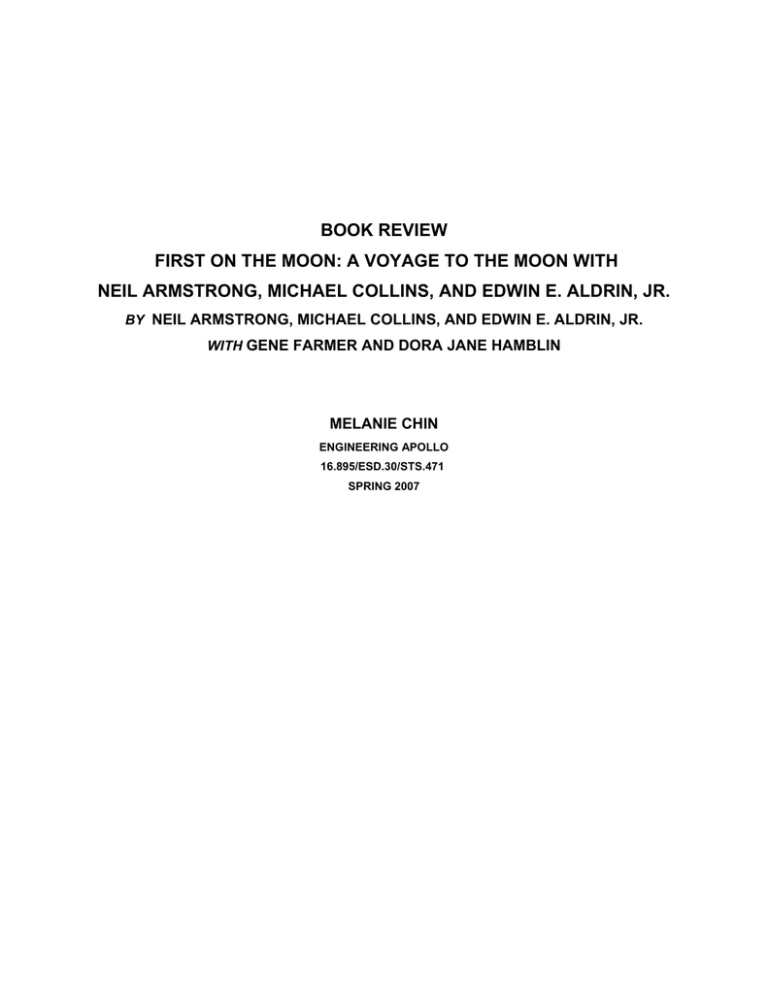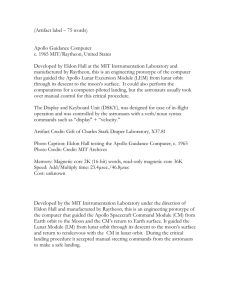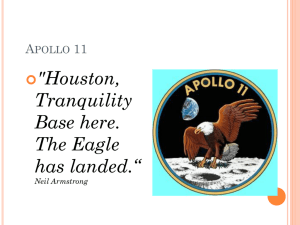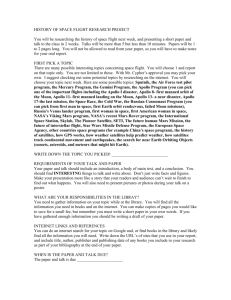BOOK REVIEW NEIL ARMSTRONG, MICHAEL COLLINS, AND EDWIN E. ALDRIN, JR.
advertisement

BOOK REVIEW FIRST ON THE MOON: A VOYAGE TO THE MOON WITH NEIL ARMSTRONG, MICHAEL COLLINS, AND EDWIN E. ALDRIN, JR. BY NEIL ARMSTRONG, MICHAEL COLLINS, AND EDWIN E. ALDRIN, JR. WITH GENE FARMER AND DORA JANE HAMBLIN MELANIE CHIN ENGINEERING APOLLO 16.895/ESD.30/STS.471 SPRING 2007 BACKGROUND First on the Moon is a detailed account of the Apollo 11 mission to the moon and the three astronauts aboard. The book is ‘written’ by Neil Armstrong, Michael Collins and Buzz Aldrin, along ‘with’ Gene Farmer and Dora Jane Hamblin. Citing the three astronauts as the ‘authors’ is true to the extent that they provided the long passages of quotes that make up much of the book. In actuality, the quotations from Armstrong, Collins, and Aldrin, as well as others peripherally related to the mission (families, other astronauts, NASA officials, etc.), were originally obtained for Life magazine’s features on the space program. Excerpts taken from these interviews are sequenced to fit into the defined chapters of the book, which was actually written by Life magazine editors Farmer and Hamblin. While narrative from all three astronauts is included, this book uniquely provides a glimpse of the mission to the moon from the perspective of Neil Armstrong, who was one of the few astronauts that did not publish his own memoir; both Buzz Aldrin and Michael Collins went on to write their own books accounting their journeys onboard Apollo 11 (Return to Earth and Carrying the Fire: An Astronaut's Journey, respectively). SOURCES Large portions of the book are in essence, biographical accounts of the astronauts, with information about and anecdotes from their childhood upbringings, educations, and careers prior to astronautics. In addition, special attention is paid to their spouses; comprehensive accounts are given of how each astronaut met his respective wife and the activities of Joan Aldrin, Jan Armstrong, and Pat Collins during the eight days of the mission are described in great (almost excruciating) detail. Given that most of the information was gathered by Life journalists and intended for publication in Life helps to explain why minutiae such as “Pat Collins started her Saturday with a nine-thirty appointment for a hair shampoo and set,”1 are included. The astronauts were celebrities; public fascination with the men extended into their personal and family lives. That their wives engaged in ‘common’ errands like going to the hairdresser or the supermarket made them relatable to their adulating public and helped promote the image of the astronauts as ‘all-American’ men with strong family values. Moreover, shedding light on the daily, albeit mundane, activities of the dutiful wives during the Apollo mission demonstrated 1 Armstrong, N, Collins, M., and Buzz Aldrin, First on the Moon, 166. their strength of character and their ability to maintain an air of calm while their husbands faced uncertain dangers in space. Interspersed with these personal accounts are transcripts from radio communications between Columbia, Eagle, and Houston during the Apollo 11 flight, chronicling the mission from lift-off to splash down. In order to make the technical jargon in these transmissions understandable to a layman, brief mention is made of the technology onboard Apollo. Beyond that, very little is devoted to the scientists and engineers who worked behind the scenes; it is clear the focus here is on the astronauts. This book was first published in 1970 and thus probably written soon or immediately after Apollo 11 splashed down in July, 1969. For this reason, it is unable to place Apollo in a broader historical perspective, which might have prompted mention of these technological achievements as one of the significant impacts of the Apollo missions. CRITICAL EXAMINATION In the bigger scheme of literature on the history of the Apollo program, as deemed by Roger Launius 2 , First on the Moon clearly falls into the category which focuses on the astronauts. In essence, the book is a human interest story right out of Life lengthened to 400 plus pages. Thus the book has a very commercial and polished appeal, with a glossy up close and personal view of the mission through the astronaut's eyes, idealizing the astronauts into supermen. Interestingly, the technological feats of the mission are downplayed; the lunar module itself is described by the astronauts as “a pretty good piece of machinery”…the “landing radar was tricky to read”…but was necessary since, “the computer would not do the job by itself.” 3 The instruments onboard Apollo 11, all had “historical antecedents” – the space sextent was derived from the astrolabe, the inertial guidance system acted as a “compass,” and the spacecraft’s computer subsystem was, “in a sense, a descendant of the first chronometer.” 4 In contrast to the oversimplification of the instrumentation onboard, a great deal of emphasis is placed on the rigorous training and skill of the astronauts, both in terms of piloting and technical competency. Buzz Aldrin’s doctorate from MIT is highlighted several times throughout the book, and he is touted as a ‘pioneer’ in the concepts of rendezvous and docking. Michael Collins describes 2 Launius, Roger. “Interpreting the Moon Landings: Project Apollo and the Historians”. Armstrong, N, Collins, M., and Buzz Aldrin, First on the Moon, 212. 4 Ibid, 143-144. 3 flying the command module as complicated as flying a B-52 bomber, “The Apollo vehicles were built not to do all these things automatically…consequently, we’ve got our fingers in all kinds of pies around the interior of that spacecraft.” 5 As such, the important roles the astronauts played and the high degree of control they had over their spacecraft is a recurrent theme throughout the book. ENGINEERING DECISION The account of the landing on the moon is appropriately filled with daring decisions, one of which involves the 12-02 alarms which signified a hardware failure onboard. The 12-02 alarm was first experienced during a powered descent simulation a month before Apollo was set to fly. The landing radar had been programmed to fail in simulation, causing the computer to turn to the landing radar for information that wasn’t available. The computer lockup resulted in a mission abort during the exercise. The first important decision was made by Gene Kranz after the 12-02 alarm failure. Most of the flight controllers thought it was not possible to get a 12-02 alarm, but Kranz called a meeting nonetheless to go over every possible program alarm that could be experienced during descent. In a technical sense, this required programmers to compile a list of all the program alarms, determine what failure it signified, evaluate whether it was critical or not, and generate protocols for handling each alarm. From a non-technical sense, this also meant a risk-benefit analysis and designation of abort scenarios: under what conditions would the landing be called off and who would make that decision. Specifically, with the 12-02 alarms, it was decided that as long as it did not recur constantly, and the computer restarted properly, the landing on the moon would proceed. Kranz’s insistence on working out every single alarm response scenario proved to be crucial. In the actual landing, there were five 12-02 alarms and one 12-01 alarm during powered descent. Ultimately, the go/no go decision was left to the guidance officer, Steve Bales. As Charlie Duke, CAPCOM during Apollo 11, recalls, “The alarms were not recurring often enough, not quite often enough, [for Steve Bales] to order an abort…the computer always fixed itself…thank God we had had that meeting after the simulation abort in June.” 6 5 6 Ibid, 255. Ibid, 240. While the book acknowledges Kranz for his critical decision, the book portrays Armstrong as the true hero of the day in the way he handled the 12-02 alarms. According to Armstrong, the computer alarms kept both astronauts very busy, “There were those alarms and there was some difficulty in getting them cleared. But we were able to continue because we had memorized the descent reasonably well.” 7 When Armstrong was finally able to look out, the LM was too low for either of them to identify any significant lunar landmarks. As they neared the surface it was becoming obvious that the system was attempting to land in an undesirable area in a boulder field. Armstrong recounts, “I was tempted to land, but my better judgment took over…I took command of the throttle to fly the LM manually the rest of the way.” 8 Despite claiming ‘control’ of the LM, Armstrong was, in fact, using the semiautomatic throttle control mode, which gave him control over the attitude and the horizontal velocity while the computer operated the throttle. But, in the framework of the book, this passage, once again, glorifies the actions and decisions of the astronauts; not only was Armstrong able to stay calm and deal with each of the 12-02 alarms, he also successfully slowed down the descent rate until an adequate landing site could be identified and was able to guide the LM to a safe touchdown. The book seems to postulate that without the skillful piloting onboard that day, Apollo 11 would not have successfully landed on the moon. From a more objective standpoint, the landing nevertheless illuminated the success of one key decision in the design of the Apollo missions to include the astronaut as an integral part of the control loop in guiding the spacecraft rather than keep him as just a passive passenger. It is clear that the book credits most of the success of the mission to the astronauts and in the question of man vs. machine, the book deems man as the victor. WORD COUNT: 1481 7 8 Ibid, 241. Ibid, 242.





